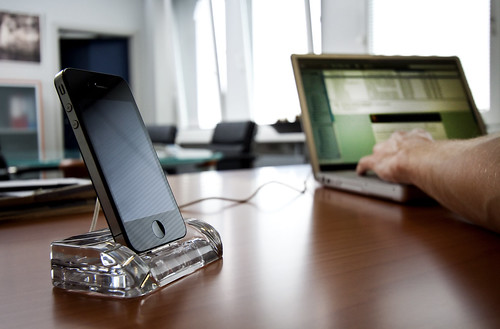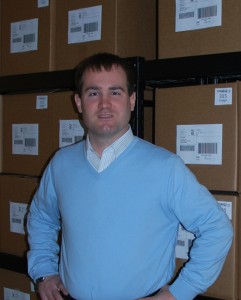Hi Matej. Tell us a few words about yourself.
Matej: I am Slovenian and live and work in the capital, Ljubljana. I am what they call a serial entrepreneur. My academic background is a B.SC. in Chemistry and MBA from the University of Kansas. I love making startups and new creative businesses, especially in the product sector. In my professional life, I have worked mainly in the media and telecommunications sectors. Last four years, I have spent as an investment director in a venture capital fund. My first startup was a contact lens retailer that in a couple of years grew to be the biggest in Slovenia; I exited this company in 2008. About a year ago, I started my second startup: CalypsoCrystal.
You have a start-up in the iPhone accessories field. What is it about?
Matej: We think that iPhone is a phenomenon. People buy the iPhone because of its design, capabilities, and also values/emotions that iPhone carries. We are sure that iPhone buyers do take care of their devices. That’s why they are buying all sorts of accessories. From cases, covers to speakers. We would like to cater to the upper segment of iPhone buyers. The ones that would like to have only exclusive, well-made accessories. That’s the story of CalypsoCrystal, the premium accessory provider.
What is the product range?
Matej: Currently, we are offering the Crystal Dock. Crystal Dock is an exclusive accessory for an iPhone made of perfect crystal glass and comes in four distinctive designs. It is a combination of traditional luxury, contemporary design, and technology.
What are the main characteristics of the docks?

Matej: Crystal Dock is made in a traditionally luxury crystal glass material used for centuries on all European courts and on special occasions. It is a demanding material that expects nothing less than precision and years of learning for the craftsman to be able to arrive at the perfect cuts and the desired shine. Just to make one of our Crystal Docks, it takes a couple of days and more than 15 pairs of hands to complete each unique piece. Every part of the Crystal Dock was carefully taken off, as the connectors example were specially designed for the Crystal Dock to perfectly fit the device and at the same time sync and recharge it.
On the design side, there are four distinctive designs; platinum painted Aurora is produced only in a limited edition whereof 999 numbered pieces. Beau with a deep cut to bring more shine, Celestia with a more organic design, and Dune that mimics the waves and brings special optical effects.
Just to give our readers an idea, where can they see the docks?
Matej: On web site www.calypsocrystal.com, there is quite a good presentation of the Crystal Dock. Furthermore, there are several premium retail outlets that offer Crystal Dock. Harrods in London, for example.
How did you come up with the idea? You wanted to do an iPhone accessory, or you wanted to do Crystal products, and the best one turned to be an iPhone dock?

Matej: We are building the premium accessory company, and we have found that the docks segment is quite empty and that we can offer a competitive edge here. Furthermore, the company’s vision is to use premium materials in our products, and using traditionally luxury material was a logical solution.
What is the targeted user?
Matej: We are looking for customers with distinctive tastes in style and design.
Can people buy the docks anywhere other than the online store?
Matej: Yes. Harrods in London, for example, or Yoox.
What was most difficult when starting the business?
Matej: Well, this is not my first start-up, so I have some experience with it. This one went quite smoothly. The biggest challenge was to produce a crystal item with specific characteristics and different usage as ever before. There was a lot of time invested in the development of the product. This is why when you look at the Crystal Dock, it seems so obvious and simple. There is a lot of advanced technology included to arrive at this result. How to include plastic connectors inside the crystal and make a product that is used on a daily basis and not only as a decoration.
Do you remember who your first customer was?
Matej: Of course. The customer came from Las Vegas.
How did it feel to have the first sale?
Matej: We just played “Viva Las Vegas” in the office and posted it on our FaceBook page to share the news with our friends.
After finding the idea about the product, what was the process of starting a business? How do you decide it has a chance to be a good business?
Matej: There was done quite some research on the potential market. The result of the research showed that the premium segment is quite unpopulated with the competition. I know that this segment is also hard to penetrate, but I simply taught it is worth a try. For some other decisions, it was just a “guts feeling” and strong faith in the product.
Did you make a business plan to see how much you need to sell to pay the bills?
Matej: Of course. This is a prerequisite for any start-up.
How did you get on the International market? What are the marketing strategies for a small business like yours?
Matej: We believe that the world is flat and therefore we are using lots of new communicating channels. We are lucky to be approached on a daily basis because the product is so outstanding from another offer on the market.
Any advice for people wanting to start a business? What should they do to go from an idea to the first day of a business?
Matej: Courage and speed. What will make or break the start-up is the time that the company needs to find its customers. Of course, you have to offer a product that reaches the highest quality standards, but even more, energy has to be spent on sales and marketing. It is crucial for the entrepreneur to discover early enough whether the product is sellable or not.




